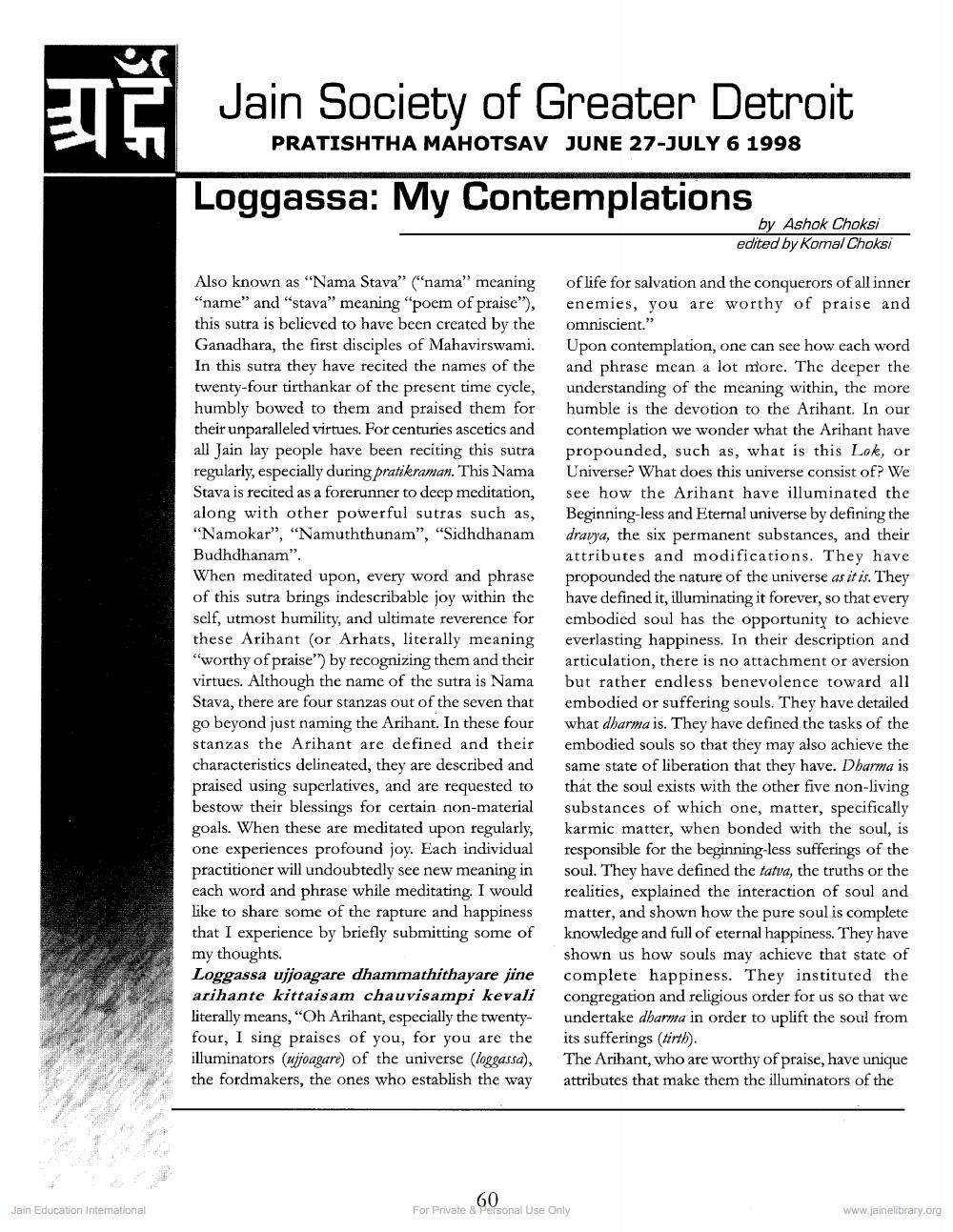________________
Jain Society of Greater Detroit
PRATISHTHA MAHOTSAV JUNE 27-JULY 6 1998 Loggassa: My Contemplations
by Ashok Choksi edited by Komal Choksi
Also known as "Nama Stava" ("nama" meaning "name" and "stava" meaning "poem of praise"), this sutra is believed to have been created by the Ganadhara, the first disciples of Mahavirswami. In this sutra they have recited the names of the twenty-four tirthankar of the present time cycle, humbly bowed to them and praised them for their unparalleled virtues. For centuries ascetics and all Jain lay people have been reciting this sutra regularly, especially during pratikraman. This Nama Stava is recited as a forerunner to deep meditation, along with other powerful sutras such as, "Namokar", "Namuththunam”, “Sidhdhanam Budhdhanam". When meditated upon, every word and phrase of this sutra brings indescribable joy within the self, utmost humility, and ultimate reverence for these Arihant (or Arhats, literally meaning "worthy of praise') by recognizing them and their virtues. Although the name of the sutra is Nama Stava, there are four stanzas out of the seven that go beyond just naming the Arihant. In these four stanzas the Arihant are defined and their characteristics delineated, they are described and praised using superlatives, and are requested to bestow their blessings for certain non-material goals. When these are meditated upon regularly, one experiences profound joy. Each individual practitioner will undoubtedly see new meaning in each word and phrase while meditating. I would like to share some of the rapture and happiness that I experience by briefly submitting some of my thoughts. Loggassa ujjoagare dhammathithayare jine arihante kittaisam chauvisampi kevali literally means, "Oh Arihant, especially the twentyfour, I sing praises of you, for you are the illuminators (ujjoagare) of the universe (loggassa), the fordmakers, the ones who establish the way
of life for salvation and the conquerors of all inner enemies, you are worthy of praise and omniscient." Upon contemplation, one can see how each word and phrase mean a lot more. The deeper the understanding of the meaning within, the more humble is the devotion to the Arihant. In our contemplation we wonder what the Arihant have propounded, such as, what is this Lok, or Universe? What does this universe consist of? We see how the Arihant have illuminated the Beginning-less and Eternal universe by defining the dravya, the six permanent substances, and their attributes and modifications. They have propounded the nature of the universe as it is. They have defined it, illuminating it forever, so that every embodied soul has the opportunity to achieve everlasting happiness. In their description and articulation, there is no attachment or aversion but rather endless benevolence toward all embodied or suffering souls. They have detailed what dharma is. They have defined the tasks of the embodied souls so that they may also achieve the same state of liberation that they have. Dharma is that the soul exists with the other five non-living substances of which one, matter, specifically karmic matter, when bonded with the soul, is responsible for the beginning-less sufferings of the soul. They have defined the tatva, the truths or the realities, explained the interaction of soul and matter, and shown how the pure soul is complete knowledge and full of eternal happiness. They have shown us how souls may achieve that state of complete happiness. They instituted the congregation and religious order for us so that we undertake dharma in order to uplift the soul from its sufferings (tirth). The Arihant, who are worthy of praise, have unique attributes that make them the illuminators of the
Jain Education Intemational
For Private & Personal Use Only
www.jainelibrary.org




